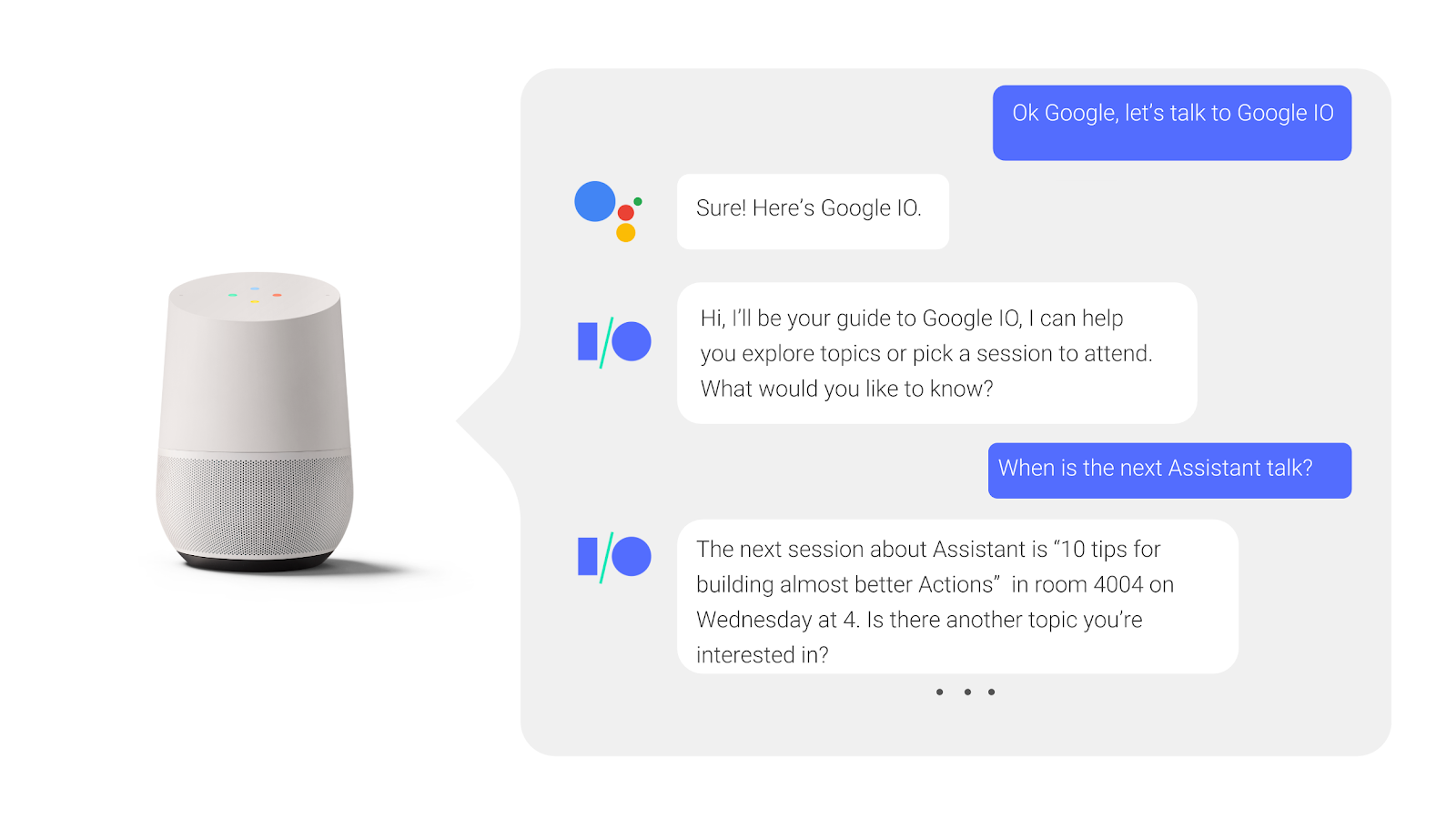إنّ "الإجراءات القائمة على المحادثة" توسّع وظائف "مساعد Google" من خلال السماح لك بإنشاء تجارب أو محادثات مخصّصة لمستخدمي "مساعد Google". في المحادثة، تعالج "الإجراء المحاور" الطلبات الواردة من "مساعد Google" وتعرض الردود التي تتضمن مكوّنات صوتية ومرئية. يمكن "لإجراءات المحادثة" أيضًا التواصل مع خدمات الويب الخارجية باستخدام الردود التلقائية على الويب لمزيد من منطق المحادثات أو الأنشطة التجارية قبل عرض الرد.

أهمية الإنشاء
تتطلّب واجهات الكمبيوتر النموذجية إدخالاً منظّمًا ويمكن التنبؤ به لتعمل بشكل سليم، ما يجعل استخدام هذه الواجهات أمرًا غير طبيعي وقد يكون صعبًا في بعض الأحيان. إذا لم يتمكن المستخدمون من معرفة هذه المدخلات المهيكلة بسهولة، فسيواجهون صعوبة في معرفة ما يجب القيام به.
على سبيل المثال، ضع في اعتبارك طلب مستخدم سهلاً مثل "كيف تبدو توقعات الطقس اليوم؟" قد يسأل آخرون أيضًا، "كيف حال الطقس الآن؟" أو "كيف ستكون درجة الحرارة في القاهرة غدًا؟" حتى مع هذا السؤال البسيط، نلاحظ أنّه يصعب تنفيذ تجارب المحادثات، لأنّ تفسير اللغة الطبيعية ومعالجتها يتطلّب برنامجًا لغويًا قويًا جدًا قادر على فهم الفروقات الدقيقة في اللغة. سيتعين على التعليمات البرمجية معالجة جميع هذه الأنواع المختلفة من الطلبات (وربما طلبات أخرى كثيرة) لتنفيذ المنطق نفسه: البحث عن بعض المعلومات المتوقعة لفترة ما وموقع. لهذا السبب، تتطلب واجهة الكمبيوتر التقليدية طلبات إدخال معيارية ومعروفة على الإضرار بتجربة المستخدم، لأنه من الأسهل التعامل مع المدخلات ذات البنية العالية.
ومع ذلك، عند إنشاء "المهام القائمة على المحادثة"، يتعامل "مساعد Google" مع تقنية فهم اللغات الطبيعية (NLU) نيابةً عنك، وبالتالي يمكنك إنشاء واجهات حوارية مفتوحة بسهولة. تتيح لك أدوات الواجهة هذه فهم الفروق الدقيقة والمتنوعة للّغة البشرية وترجمة ذلك إلى معنى عادي ومنظّم يمكن لتطبيقاتك وخدماتك فهمه. لنلقِ نظرة على كيفية تعامل "الإجراء" مع الأمثلة السابقة لطلبات توقعات الطقس.

للبحث عن توقعات الطقس، قد تحتاج إلى بعض المعلومات، مثل الوقت الذي يريد المستخدمون فيه توقع الطقس وموقعهم. ومع ذلك، كما ذكرنا سابقًا، قد يطلب مستخدمون مختلفون توقّعات بطريقة مختلفة. يمكن لخدمة "مساعد Google" فهم هذه الاختلافات وترجمتها إلى هدف عادي من المستخدمين للاطّلاع على التوقّعات. يمكنها بعد ذلك تحليل طلب المستخدم للبيانات ذات الصلة التي تحتاجها لتنفيذ الطلب. في هذه الحالة، هذا هو الوقت والموقع المطلوبين للمستخدم لتوقعات الطقس. أخيرًا، يمكنك استخدام هذه البيانات للبحث عن حالة الطقس باستخدام واجهة برمجة تطبيقات REST API المتاحة للجميع وعرض حالة الطقس إلى المستخدم في شكل رسالة مطالبة.
حالات الإنشاء
تعمل "المهام القائمة على المحادثة" على أفضل وجه في حالات الاستخدام البسيطة التي تتيح للمستخدمين إنجاز المهام بسرعة، بالإضافة إلى حالات الاستخدام الشاملة التي تتم من خلال إعادة توجيه الصوت. غالبًا ما تندرج إجراءات المحادثة الجيدة ضمن الفئات العامة التالية:
- أسئلة يستطيع المستخدمون الإجابة عنها بسهولة: الإجراءات التي يمكن إنجازها باستخدام مدخلات مألوفة مثل الأوقات أو التواريخ، مثل حجز رحلة جوية.
- إجراءات سريعة ومفيدة في الوقت نفسه: عادةً ما يمنح ذلك المستخدمين فائدة فورية لوقت قصير جدًا يقضونه، مثل معرفة متى سيلعب فريقهم الرياضي المفضل في المرة التالية.
- الإجراءات الأكثر ملاءمةً للصوت: وعادةً ما تكون هذه هي المهام التي تريد ممارستها بدون لمس الجهاز، مثل تلقّي التدريب أثناء اليوجا أو التمارين الخفيفة أو الألعاب المصمّمة للتفاعل مع الصوت أولاً.
كيفية الإنشاء
تتيح لك "المهام مع مساعد Google" إنشاء "إجراءات قائمة على المحادثة" إما باستخدام حزمة تطوير البرامج (SDK) للإجراءات أو "أداة إنشاء الإجراءات" أو كليهما بالتبادل. تتيح لك هذه الميزة اختيار أفضل سير عمل للتطوير لاحتياجاتك، مع منحك المرونة للتبديل ذهابًا وإيابًا عند الحاجة.
توفّر حزمة تطوير البرامج (SDK) لحزمة "المهام مع مساعد Google" مخططًا موحّدًا يستند إلى ملفات لإنشاء المهام، ومكتبات للتفاعل مع "مساعد Google"، وواجهة سطر الأوامر لنشر مشروع الإجراءات وإدارته. تم تصميم "أداة إنشاء المهام" فوق التكنولوجيا نفسها المتاحة في حزمة تطوير البرامج (SDK) للإجراءات، وتتيح لك إنشاء نموذج باستخدام بيئة تطوير متكاملة (IDE) سهلة الاستخدام وفعّالة.
يُرجى الاطّلاع على نظرة عامة على الإصدار للحصول على مزيد من المعلومات.
الخطوات التالية
اطلع على الموارد التالية لبدء الإنشاء الآن:
- دليل البدء السريع: اطّلِع على مقدّمة سريعة حول طريقة إعداد بيئتك وبدء التطوير باستخدام "حزمة تطوير البرامج (SDK)" و"أداة إنشاء المهام".
- الدروس التطبيقية حول الترميز: تقدّم الدروس التطبيقية حول الترميز جولات تفصيلية ومفصّلة حول كيفية إنشاء "مهام" لخدمة "مساعد Google".
- عيّنات - احصل على جميع نماذجنا على جيت هب لبدء التجربة الآن.

